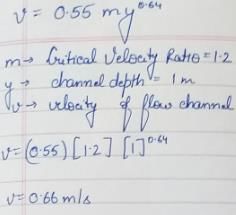Test: Sediment Transport & Design of Irrigation Channel - 2 - Civil Engineering (CE) MCQ
10 Questions MCQ Test - Test: Sediment Transport & Design of Irrigation Channel - 2
A stable channel has three degrees of freedom in the sense that the depth, width and slope can adjust to the given discharge and sediment conditions. In this sense which of the following methods of canal design gives a true regime channel for silt laden flow in fine alluvium?
If it is required to design a stable channel for a given discharge in an alluvial material of known median size, it can be done by least number of assumptions concerning the important variables by using
Lacey, in his regime equations, has adjusted his silt factor to be unity for the standard silt used by Kennedy. It is known that Kennedy used Bari-Doab alluvium as the standard silt in his equation. Then, the median size, in mm, of Bari-Doab alluvium and the critical velocity ratio for this silt are, respectively
Average bed material load of a regime channel conforming to Lacey equations will be of the order of
The total number of independent equations that form the Lacey's regime theory is
The velocity of flow in a channel with a depth of 1 mt calculated by Kennedy’s theory with a critical velocity ratio as 1.2 is
A regime channel has a discharge of 100 m3/s. It will have a perimeter of
When an alluvial channel attains its regime it will have side slopes
For medium silt whose average grain size is 0,16 mm, Lacey’s silt factor is likely to be
The Lacey’s silt factor for a particular alluvium is 2.0. This alluvium would comprise



















